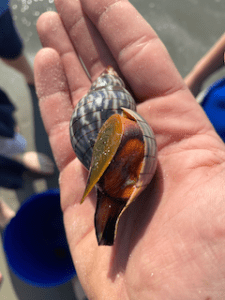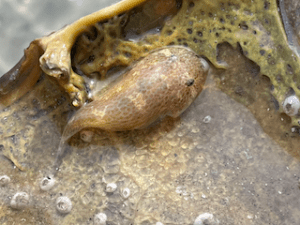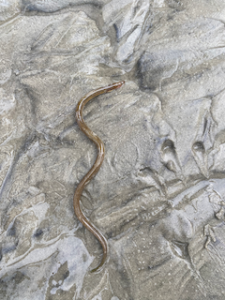Spring Cling…fish and friends!
Spring is spranging down here in the low country and with that we’ve been finding some interesting critters on Capers Island! In addition to the pollen arriving we have seen cannon ball jellies arriving—this usually indicates to us warmer water (and hopefully sea turtles!) are on the way.
The first species we’d like to highlight that was found recently is a type of live sea snail called the banded tulip. These snails can be found living along sandy or muddy bottoms and along oyster beds. Their prey items include bivalves like clams, oysters, and other snails. Similar to the moon snail they have “radula”which is a toothed tongue that it uses to drill into its prey. Snails belong to the phylum gastropoda meaning “stomach foot”.

Banded tulip sea snail!
Another interesting animal we found belongs to the phylum chordata, or animals that contain notochords. It is the skilletfish aka the oyster clingfish and is in the Gobiesocidae family. It does have a skillet shaped body and as its other common name implies it is typically found clinging on to different shells (or in this case a molt of a horseshoe crab). The clinging is done because they have a unique suction disc feature made out of their specially adapted pelvic fins. They feed on worms and little crustaceans like amphipods.

Oyster clingfish aka a skilletfish in a horseshoe crab shell.
The third recent cool find is called a shrimp snake eel! It is found inshore along sandy, muddy soft bottoms. Its diet consists of bony fishes, bottom dwelling shrimps and crabs, and sometimes even cephalopods (octopus, squids, cuttlefish). Usually these eels are burrow in the sand during daylight and emerge to hunt in the evening. We’ve been finding a lot of the eels in the washout area on Capers when the tide is quite low and the school groups find great joy in running the squirming eels to the receded water!

Shrimp eel exposed after the tide receded.
